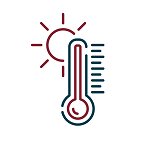
As regional wildfire events affect local air quality, Santa Clara University staff actively monitors the effects of wildfire smoke particle pollution on the campus community via AirNow for the city of Santa Clara and Berkeley.
For current air quality that uses both regulatory-grade monitors and supplemental consumer-grade PurpleAir* monitors, navigate to AirNow's Fire and Smoke Map. Note: the Fire and Smoke Map shows information on particle pollution (PM2.5), fires and smoke plumes.
Here are steps you can take to reduce your risk from wildfire smoke:
-
Keep indoor air as clean as possible if you are advised to stay indoors. Keep windows and doors closed. Run an air conditioner, but keep the fresh-air intake closed and the filter clean to prevent outdoor smoke from getting inside.
-
If you do not have an air conditioner and it is too warm to stay inside with the windows closed, go to a designated shelter away from the affected area.
- Avoid activities that increase indoor pollution. Burning candles, fireplaces, or gas stoves can increase indoor pollution. Vacuuming stirs up particles already inside your home, contributing to indoor pollution. Smoking also puts even more pollution into the air.
- Do not rely on dust masks for protection. Paper “comfort” or “dust” masks commonly found at hardware stores are designed to trap large particles, such as sawdust. These masks will not protect your lungs from the small particles found in wildfire smoke.
Severe weather can happen anytime.
Severe weather can include hazardous conditions produced by thunderstorms, including damaging winds, tornadoes, large hail, flooding and flash flooding, and winter storms associated with freezing rain, sleet, snow and strong winds.
America’s wireless industry is helping to build a Weather-Ready Nation through a nationwide text emergency alert system, called Wireless Emergency Alerts (WEA), which will warn you when weather threatens. More information at https://www.weather.gov/wrn/wea
Extreme heat is a period of high heat and humidity with temperatures above 90 degrees for at least two to three days. In extreme heat your body works extra hard to maintain a normal temperature, which can lead to death. In fact, extreme heat is responsible for the highest number of annual deaths among all weather-related hazards.
Remember:
-
Extreme heat can occur quickly and without warning.
-
Older adults, children and sick or overweight individuals are at greater risk from extreme heat.
-
Humidity increases the feeling of heat as measured by a heat index.
If you are under an extreme heart warning:
-
Find air conditioning.
-
Avoid strenuous activities.
-
Wear light clothing.
-
Check on family members and neighbors.
-
Drink plenty of fluids.
-
Watch for heat cramps, heat exhaustion and heat stroke.
-
Never leave people or pets in a closed car.
How to stay safe when extreme weather threatens:
During hot weather, specific facilities in the City of Santa Clara are designated as cooling centers, locations where the public may come to get out of the heat during normal business hours. If chairs are set up for the public to sit down, their location should not impede building egress, such as near entrances or in hallways. The County of Santa Clara provides additional information on the County website for cooling centers and services during hot weather.
Try to keep your home cool:
- Do not rely on a fan as your primary cooling device.
- Cover windows with drapes or shades.
- Weather-strip doors and windows.
- Use window reflectors such as aluminum foil-covered cardboard to reflect heat back outside.
- Add insulation to keep the heat out.
- Install window air conditioners and insulate around them.
- Recognize the signs and symptoms of heat illness.
- More information about the University's Heat Illness Prevention Program
*If you use PurpleAir and compare it to the official AQI on AirNow, you likely will notice some differences.
Wildfire smoke can cause inaccuracy in the PurpleAir monitors, skewing the results high. The PurpleAir Map website comes with an easy conversion factor you can apply when the majority of the air pollution is from wildfire smoke.
You can choose the options of LARPA, AQandU, WOODSMOKE, or US EPA to see a truer representation of the air quality during wildfire smoke events. More information on conversions can be found HERE.